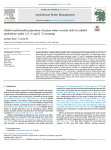Rosa L., He L. (2025). Global multi-model projections of green water scarcity risks in rainfed agriculture under 1.5 °C and 3 °C warming. Agricultural Water Management, 01/06/2025, vol. 314, p. 109519.
https://doi.org/10.1016/j.agwat.2025.109519
https://doi.org/10.1016/j.agwat.2025.109519
| Titre : | Global multi-model projections of green water scarcity risks in rainfed agriculture under 1.5 °C and 3 °C warming (2025) |
| Auteurs : | L. Rosa ; L. He |
| Type de document : | Article |
| Dans : | Agricultural Water Management (vol. 314, June 2025) |
| Article en page(s) : | p. 109519 |
| Langues : | Anglais |
| Langues du résumé : | Anglais |
| Catégories : |
Catégories principales 07 - ENVIRONNEMENT ; 7.3 - Eau. Gestion de l'EauThésaurus IAMM AGRICULTURE ; EAU DISPONIBLE ; PENURIE ; CULTURE PLUVIALE ; PROJECTION ; CHANGEMENT CLIMATIQUE ; RECHAUFFEMENT GLOBAL |
| Résumé : | Rainfed agriculture, sustaining billions globally, faces escalating threats from climate change, yet the role of green water (soil moisture) in quantifying these risks remains critically understudied. We quantify green water scarcity (GWS)—insufficient rainfall to meet crop needs—under 1.5°C and 3°C warming, tracking shifts in risk categories (reliable, risky, highly risky) based on monthly water stress duration. At baseline (1996–2005), 25 % of global rainfed croplands (183 million hectares, Mha) are classified as reliable (≤1 month of GWS annually). However, with 1.5°C and 3°C of global warming, the risk of GWS increases noticeably, resulting in the loss of 70 Mha and 106 Mha of reliable rainfed croplands, respectively, shifting them into risky or highly risky categories. This degradation jeopardizes food production for 0.8 billion people at 1.5°C and 1.2 billion at 3°C, disproportionately impacting regions reliant on rainfed systems. Crucially, 3°C warming doubles the spatial extent of severe GWS compared to 1.5°C, underscoring the nonlinear rise in agricultural risks with temperature. Our analysis reveals that limiting warming to 1.5°C could preserve croplands that feed 400 million people, highlighting the urgent need for climate mitigation. These findings demand integrated water-resilient strategies—prioritizing soil moisture conservation, adaptive crop choices, and sustainable irrigation—to safeguard global food security. By bridging green water dynamics with climate targets, we provide a roadmap for stabilizing rainfed agriculture in a warming world. |
| Cote : | En ligne |
| URL / DOI : | https://doi.org/10.1016/j.agwat.2025.109519 |







